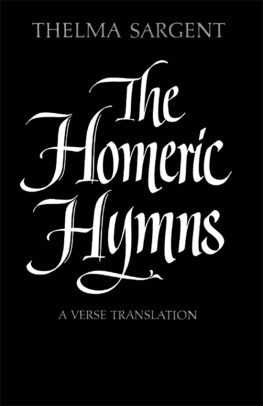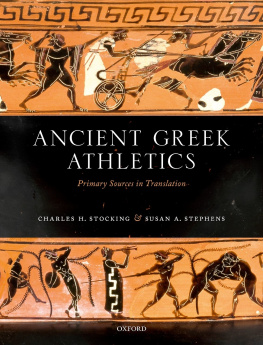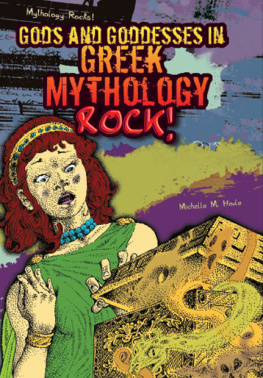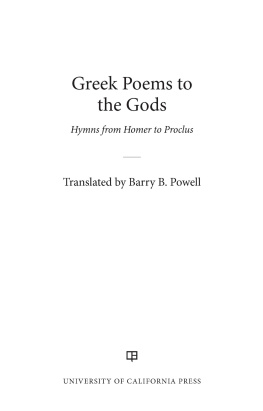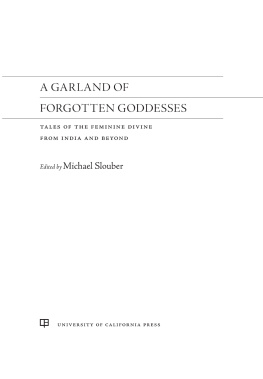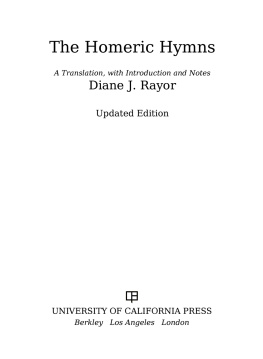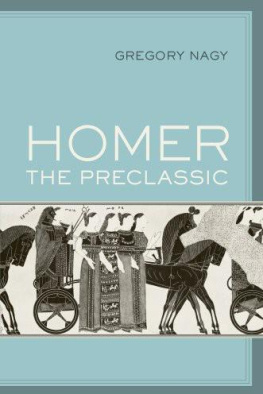Sargent - The Homeric hymns: a verse translation
Here you can read online Sargent - The Homeric hymns: a verse translation full text of the book (entire story) in english for free. Download pdf and epub, get meaning, cover and reviews about this ebook. City: New York, year: 1975, publisher: W. W. Norton & Company, genre: Romance novel. Description of the work, (preface) as well as reviews are available. Best literature library LitArk.com created for fans of good reading and offers a wide selection of genres:
Romance novel
Science fiction
Adventure
Detective
Science
History
Home and family
Prose
Art
Politics
Computer
Non-fiction
Religion
Business
Children
Humor
Choose a favorite category and find really read worthwhile books. Enjoy immersion in the world of imagination, feel the emotions of the characters or learn something new for yourself, make an fascinating discovery.
- Book:The Homeric hymns: a verse translation
- Author:
- Publisher:W. W. Norton & Company
- Genre:
- Year:1975
- City:New York
- Rating:5 / 5
- Favourites:Add to favourites
- Your mark:
- 100
- 1
- 2
- 3
- 4
- 5
The Homeric hymns: a verse translation: summary, description and annotation
We offer to read an annotation, description, summary or preface (depends on what the author of the book "The Homeric hymns: a verse translation" wrote himself). If you haven't found the necessary information about the book — write in the comments, we will try to find it.
Sargent: author's other books
Who wrote The Homeric hymns: a verse translation? Find out the surname, the name of the author of the book and a list of all author's works by series.
The Homeric hymns: a verse translation — read online for free the complete book (whole text) full work
Below is the text of the book, divided by pages. System saving the place of the last page read, allows you to conveniently read the book "The Homeric hymns: a verse translation" online for free, without having to search again every time where you left off. Put a bookmark, and you can go to the page where you finished reading at any time.
Font size:
Interval:
Bookmark:
 W. W. Norton & Company, Inc. 500 Fifth Avenue, New York, N.Y. 10110 www.wwnorton.com W. W.
W. W. Norton & Company, Inc. 500 Fifth Avenue, New York, N.Y. 10110 www.wwnorton.com W. W.
Norton & Company Ltd. Castle House, 75/76 Wells Street, London W1T 3QT COPYRIGHT 1973 BY W. W. NORTON & COMPANY, INC. First Published in the Norton Library 1975 Books That Live The Norton imprint on a book means that in the publishers estimation it is a book not for a single season but for the years. W. W.
Norton & Company, Inc. The Library of Congress has cataloged the printed edition as follows: Homerus. The Homeric hymns. I. Sargent, Thelma, tr. Title. Title.
PA4025.H8S3 1973 883.01 7212937 ISBN13: 978-0-393-00788-6 ISBN10: 0-393-00788-X ISBN : 978-0-393-35194-1(e-book) ALL RIGHTS RESERVED Translated by THELMA SARGENT THE HOMERIC HYMNS THE IDYLLS OF THEOCRITUS T HE HOMERIC HYMNS are a collection of anonymous poems of varying length and quality celebrating the gods and goddesses of the Greek pantheon and composed for the most part around the seventh century B.C. They are in the oral tradition of bardic poetry, with the stately six-foot measures of dactylic hexameter, the meter of the great epics of Homer. The ancients had no hesitation in attributing the hymns to Homer. Thucydides (3.104), possibly because of the autobiographical reference to a blind bard from Chios in the Delian Apollo (3a.17273), comes right out with it, quoting Homer on the Delian games. Pausanias, too, though he cites other islands that claim the great poet as their own, refers unequivocally to the hymns of Homer (9.30.12). Even in Shelleys time, there was evidently no doubt; his translation of Hermes (4) is entitled Homers Hymn to Mercury.
But today it is generally accepted that the hymns are not the work of Homer but were composed at a later date by a number of poets, whose identity has been lost in the misty past. For a while one Cynaithos of Chios (ca. 500 B.C.) was credited with the Delian Apollo on the authority of a scholiast on Pindar, but the datea mere half century before Thucydidesis much too late. At any rate, whoever he was, the author of the Delian Apollo was a very fine poet indeed, second only to the creator of the hymn to Demeter (2). The Delian Apollo (3a) and Aphrodite (5) are thought to be the earliest of the hymns, probably dating back to the eighth century. The Pythian Apollo (3b), like Demeter (2) and the majority of the hymns, is placed in the seventh century, Pan (19) in the fifth.
Ares (8) is thought to be very lateof the Hellenistic period, or perhaps even as late as the fifth century A.D. Certainly this short hymn has a strangely modern tone and the god of war has undergone a mighty transformation. The form of the poems is the prooimion, which means prelude or preface. The question is, a prelude to what? It is generally assumed that they preceded a longer recitation, but in the case of the longer narratives this seems unlikely. I wonder if they might not, instead, have been invocations such as are offered nowadays at the opening of our public ceremonies. Just as some divines are more eloquent than The meter is the dactylic hexameter of the epics; that is, a six-foot line, each foot composed of a long syllable followed by two short ones (..).
But there are many variations. A syllable that is long by nature (containing a long vowel or a diphthong), or by position (containing a short vowel followed by two or more consonants), may take the place of two short syllables ( ); sometimes three short syllables are elided into two; sometimes there is a fractional pause for breath; and the last foot is restricted to two syllables, the second of which may be either long or short. The first lines of the major hymns scan as follows:
| Demeter | / .. / / .. / |
| Delian Apollo | .. / .. / / .. / . |
| Pythian Apollo | .. / .. / / .. / .. / |
| Hermes | / / .. / / . |
| Aphrodite | .. / .. / .. / / .. / |
But although the rhythm is that of the epics, the stories themselves are simple and pleasantlight entertainment for the lighter moments of life. Not many poets have been impelled to translate these lovely poems. While both Congreve and Shelley have translated a hymn or two and a few lesser poets have translated others, the only complete and more or less faithful translation I know of if not the only, scholarship in the field is the exhaustive study The Homeric Hymns, by Thomas W. Allen, William R. Halliday, and Edward E. Sikes (Oxford, 1936); Evelyn-White acknowledges his debt to the 1904 edition of Allen and Sikes and has obviously incorporated the best of their interpretations in his text and translation in the Loeb edition cited above.
Interested readers may consult these books for more detailed information, but even the existing scholarship has been considerably modified by more recent work in archeology and other related fields. In my translation I have in general followed the text of the Loeb edition, referring to that of Thomas W. Allen (Homeri opera, vol. 5 [Oxford, 1912; 1961 printing]) here and there along the way when questions arose, as they often did. I have adopted a hybrid system of transliteration for the Greek names. Where the Latin form is the one familiar to the average reader of English poetry (Olympus, Phoebus, Calypso), I have used that form.
Otherwise, I have used the Greek form. However, because the letter k has a foreign look in English, and because c is hard before consonants and the vowels a, o, and u anyway, I have used c in all cases except Knossos (but, inconsistently, Crete). That is the spelling familiar to twentieth-century tourists, who, though not usually schooled in the classics, do get around. Faced with dactylic hexameter, every translator has to decide for himself how he will render it in English. Some poets settle for iambic pentameter, probably the easiest rhythm of all in our language, the meter of the sonnet and of Shakespeares plays, and, unless we watch out, the rhythm into which much of our speech naturally falls (I mailed the letter on my way to work). Some favor a longer, seven-foot line, iambic or otherwise, but despite its appearance, it invariably breaks down in reading to the jingly ballad rhythm of alternate four- and three-foot lines (And this was odd because it was the middle of the night).
And some have opted for the six-stress line, whose rhythm is so subtle as to be almost indiscernible. The difficulty is that narrative poetry is supposed to entertainto tell a storyand dactylic hexameter is much too ponderous and portentous in tone for such a purpose. In our language it is unwieldy as well. Word order is important in English. The weak, unobtrusive little connectives and, but, or, nor, for, so essential in a sustained narrativeand inevitable in the paratactical constructions of epic poetryhave to precede the emphatic syllable that is supposed to begin the line. Greek is more fortunate; the connectives can follow the words they connect without resulting in hopeless confusion.
Moreover, in an uninflected language such as ours, modifiers must come immediately before or after the word they modify. In Greek, if metrics demand, three or four lines may separate the twoagain without confusion because the case endings indicate the relationship between the words of a sentence. I have attempted a compromiseto convey the flavor of the rhythm of the Greek, but within the more comfortable framework of the five-foot line. However, it is only a general framework. When considerations of sound or sense were more important, I have without a qualm broken my own rules. Sometimes, to relieve the monotony, I have thrown in a four-, six-, or even seven-foot line, and my dactyls, because of the matter of word order, are amphibrachs or anapests as often as not.
Next pageFont size:
Interval:
Bookmark:
Similar books «The Homeric hymns: a verse translation»
Look at similar books to The Homeric hymns: a verse translation. We have selected literature similar in name and meaning in the hope of providing readers with more options to find new, interesting, not yet read works.
Discussion, reviews of the book The Homeric hymns: a verse translation and just readers' own opinions. Leave your comments, write what you think about the work, its meaning or the main characters. Specify what exactly you liked and what you didn't like, and why you think so.

